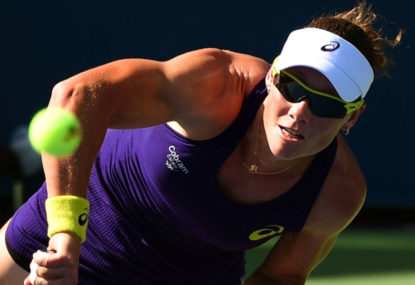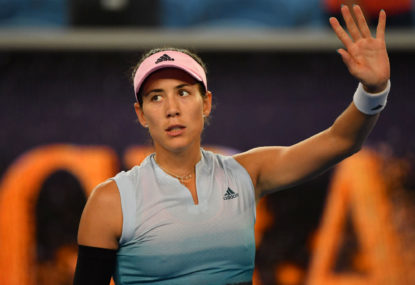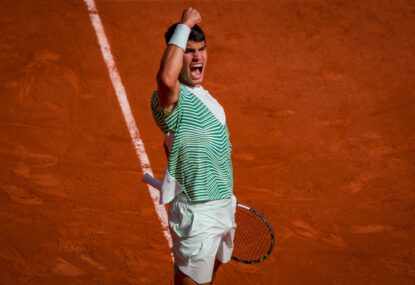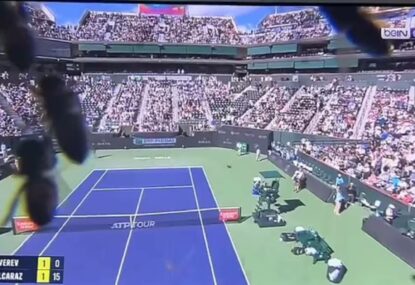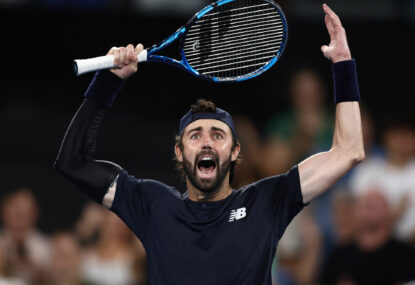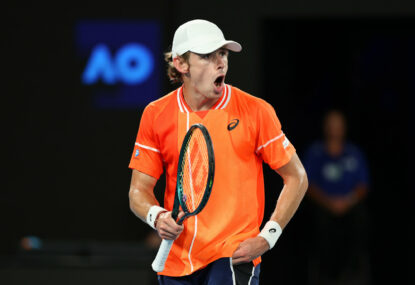During the Australian Open tennis several years ago I was shopping for a new television and, with my granddaughter in tow, went to one of those big electronics retailers who had a whole wall of TV sets on display.
As I pondered the excess of choice before me, my granddaughter suddenly shouted and pointed excitedly to a screen showing coverage from Melbourne Park.
“Buy that one!” she exclaimed. “It’s got Roger Federer in it!”
My decision to buy tickets to the Fast4 tennis staged in Sydney earlier this week was based on fairly similar logic really. And I suspect the “it’s got Roger Federer in it!” factor was the key to selling out the Qantas Credit Union Arena several weeks in advance.
So, when someone asked me the day after the event if I thought the Fast4 format “lived up to the hype” I was a bit non-plussed. Hype? The Fast4 format was a detail in the fine print. Literally.
The event was actually billed and ticketed as “one night with Roger Federer and Lleyton Hewitt.” I’d been hyped up to see Federer not the format.
The man I rate the greatest sportsman of my lifetime only makes rare excursions into Sydney so I wasn’t going to miss it.
I knew it wouldn’t be anything more than an exhibition match but, hell, I’d pay good money to watch Federer live if he was just shelling peas. In fact, I think I saw a telecast from Brisbane last week where he did pretty much that against James Duckworth.
But, as Channel Nine promoted the event during their Test cricket coverage over the summer, I became aware that the occasion was especially designed to test drive “tennis’ answer to Twenty20 cricket”.
(See, you have a word and you tack a numeral onto the end of it: Twenty20, Fast4 – which is a bit awkwardly like netball’s Fast5 – but never mind, you get the gist.)
Still, I’ll confess the experimental format and how it would work was hardly front of mind for me when I rocked up to the venue formerly known as the Sydney Entertainment Centre. I assumed the ins and outs of Fast4 tennis would be explained on the night, which turned out to be a bit naive of me.
I gather the TV audience had someone run through the rule modifications, but the patrons who’d shelled out their $75 a ticket were left somewhat on their own to figure out what was going on.
The format name had given me the tip that the sets were played to four points rather than six and I had heard there would be no “advantage rule” in the scoring.
In other words, there was no need for a player to be two ahead of his opponent to take the game or the set. So, while you can never win a set 6-5 in conventional tennis scoring, you could take a set 4-3 in Fast4.
What it took me a while to figure out was that once the score in any game reached deuce and the winner of the next point was awarded the game, there was a tweak that meant the server didn’t hold all the cards.
The player receiving serve was allowed to choose which side of the court the server had to serve to, so he had a choice of receiving serve to either his forehand or backhand.
The chair umpire was announcing this but, with his beautifully heavy French accent it was sounding something like ‘reservoirs chess’ and despite all my years of listening to Arsene Wenger interviews, I had to ask someone nearby what he was saying.
The clarity of the situation wasn’t helped by the big screen pumping out an ominous, throbbing, heartbeat sound effect accompanied by a declaration in bold type ‘PowerPoint’. It felt more like WhitePointer than PowerPoint, such was the similarity to ‘enter the shark’ theme from Jaws.
During the legends doubles fixture before hand, a mic’d up Pat Cash had observed “PowerPoint? I think I’ve got that on my computer at home.”
It was all very well to be made aware that this was a PowerPoint, but it would’ve been nice to know exactly what that meant. I knew the format was tennis ‘de-deuced’, but I shouldn’t have had to deduce that myself.
The significance of the PowerPoint, of course, was that “deuce” always meant the game was one point away from being decided, which moves things along at a rapid pace.
The tiebreaker format was abbreviated as well. First to five took the set, even if the margin was only one point but what I only realised mid-match was that the tiebreaker was used if the score got to 3-3. I’m not good with numbers and, given the title Fast4, a tiebreaker to five points at three-all in a best of five sets match had my head hurting a little bit.
I liked the idea that there was no repeat serve in the case of a ‘let’. If a ball clipped the net it was either in play or out and play proceeded accordingly. That seems a rule that could easily be adopted into the mainstream but it’s not like it’s something that happens so regularly that the modification would speed games up much.
But, for all the mild confusion about exactly how the game was being scored, it was hugely entertaining. Federer and Hewitt went at it with real gusto and the shot-making ability, especially of Federer, was enough to keep even the most perplexed spectator transfixed.
I spoke with former Davis Cup captain, John Alexander, at the Sydney International the next day and he said he was amazed how hard Federer went at it considering he’d played a tough three set final in Brisbane against Milos Raonic the previous night.
The Swiss maestro won 4-3 2-4 3-4 4-0 4-2 in 92 minutes and Alexander said that when Hewitt took the second and third sets he thought Federer might have been done and dusted given his heavy schedule. But a fourth set to love put paid to that idea. That set, indeed, was a fast four.
Post match both Federer and Hewitt professed to have enjoyed the contest, and the camaraderie – albeit still very competitive – between the two was clearly part of the pleasure. But neither seemed keen on predicting it would have any place at the elite level. Both talked about it being a way for juniors and social players to compete without the possibility of matches being drawn out and time-budgeting being a problem.
Federer did however make the observation that the format would suit broadcasters who find tennis difficult to schedule, given the open-ended time frame of the traditional format. But having said that, the 17-time grand slam singles winner said the uncertainty about whether a match would go for 45 minutes or three hours is something he loves about tennis and doesn’t want it tampered with.
In theory I can see how the format could be valuable for pragmatic reasons at the non-elite level of tennis. But, the question I keep asking myself is, if juniors and social players aren’t seeing it played by the stars of the sport, will it have much appeal?
Maybe the fact Federer and Hewitt didn’t seem keen to talk up the possibility of Fast4 elite level tennis doesn’t mean it won’t happen. When the tiebreaker was first introduced into grand slam tennis at the US Open in 1970 players were generally against it but the director of the tournament Bill Talbert shrugged off their objections saying …”the fans will love it. Did you ever know a player who bought a ticket?”
It’s also worth bearing in mind that the tiebreak was introduced to elite level tennis as a result of another modified version of the sport that was trialled in the US called VASSS, or Van Alen Streamlined Scoring System.
Most of Jimmy Van Alen’s proposed modifications (like first to 21-points scoring) fell by the wayside, but the tiebreak idea had its first incarnation in his tournaments in the mid fifties and eventually found its way into the mainstream. So maybe something from Fast4 will spill over into elite tennis as we know it.
The acceptance of the service let perhaps?
But coming away from Monday night’s experience I wasn’t convinced I’d seen the future. I do know I saw tennis history – and it wasn’t the trialling of a new format. It was Federer, who’ll be talked about in tennis for decades to come.
Indeed the best thing about Fast4 tennis on Monday night was “it had Roger Federer in it.”





























































































